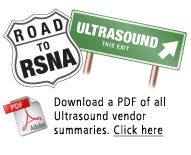The field of ultrasound has been anything but quiet over the past year.
Ultrasound contrast advocates made progress in addressing a controversy over product safety that began in October 2007, when the U.S. Food and Drug Administration (FDA) issued a black box warning for two contrast agents, Definity by Lantheus Medical Imaging of North Billerica, MA, and Optison from GE Healthcare of Chalfont St. Giles, U.K.

On the instrumentation side, advances in ultrasound technology continue to be developed both for portable ultrasound systems and their larger full-sized cohorts. More powerful transducers, additional image processing capabilities, and new clinical features have gained traction, while fused image techniques that combine real-time ultrasound with previously captured CT, MR, or PET images have moved to the fore. Ergonomic design also has retained its importance.
Elastography has taken hold as a technique for measuring tissue elasticity. Tumor characterization seems to be the most promising application, as this technology is used to determine which lesions are cystic and which are solid in composition.
Also look for information about breast ultrasound computer-aided detection (CAD) to be featured at this year's meeting, with a new study published in October 2008 in the American Journal of Clinical Oncology suggesting that breast CAD appears to aid in the detection of breast lesions smaller than 1 cm. This approach seems to hold promise for future delineation of which lesions might require biopsy and which might not.
Ultrasound continues to enjoy a positive reputation as a valuable means of imaging in a number of different clinical applications, from cardiac and vascular to detecting a variety of lesions throughout various organ systems. As manufacturers develop even more new capabilities, its utility should continue to emerge.



















